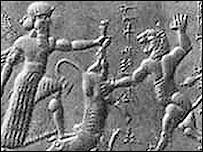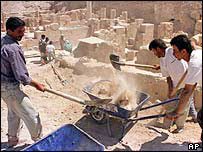|
Archaeologists in Iraq
believe they may have found
the lost tomb of King
Gilgamesh
- the subject of the oldest "book" in history.
|
The Epic Of Gilgamesh - written by a Middle Eastern scholar 2,500 years
before the birth of Christ - commemorated the life of the ruler of the
city of Uruk, from which Iraq gets its name.
Now, a German-led expedition has discovered what is thought to be the
entire city of Uruk - including, where the Euphrates once flowed, the
last resting place of its famous King.
"I don't want to say definitely it was the
grave of King Gilgamesh, but
it looks very similar to that described in the epic," Jorg Fassbinder, of the
Bavarian department of Historical Monuments in Munich, told the
BBC World Service's Science in Action program.
|

Gilgamesh was believed to be two-thirds god, one-third human.
|
Magnetic
In the book - actually a set of inscribed clay tablets - Gilgamesh was
described as having been buried under the Euphrates, in a tomb
apparently constructed when the waters of the ancient river parted
following his death.
"We found just outside the city an area in the middle of the former
Euphrates river¿ the remains of such a building which could be
interpreted as a burial," Mr Fassbinder said.
|
He said the amazing discovery of the ancient city under the Iraqi desert
had been made possible by modern technology.
"By differences in
magnetization in the soil, you can look into the
ground," Mr Fassbinder added.
"The difference between mudbricks and sediments in the Euphrates river
gives a very detailed structure."
|
|
This creates a magnetogram, which is then digitally mapped, effectively
giving a town plan of Uruk.
'Venice in the desert'
|

Iraq has long been
the site of some of the most important historical finds |
"The most surprising thing was that we found structures already
described by Gilgamesh," Mr Fassbinder stated.
"We covered more than 100 hectares. We have found garden structures and
field structures as described in the epic, and we found Babylonian
houses."
But he said the most astonishing find was an incredibly sophisticated
system of canals.
"Very clearly, we can see in the canals some structures showing that
flooding destroyed some houses, which means it was a highly developed
system.
"[It was] like Venice in the desert."
|
|


